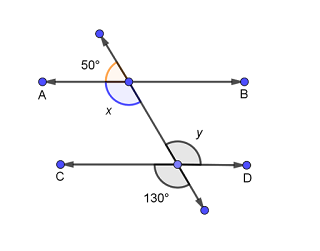Q1.
In the given figure, sides QP and RQ of Δ PQR
are produced to points S and T respectively. If ∠SPR
= 135° and ∠PQT
= 110°, find ∠PRQ.
Given: Δ PQR,
∠SPR = 135° and ∠PQT = 110°
To
find: ∠PRQ
Solution: ∠PQR + ∠PQT = 180° (Linear pair)
⇒ 110°
+ ∠PQR = 180°
⇒ ∠PQR
= 180° – 110° = 70°
Now, ∠SPR
= ∠PQR + ∠PRQ (Exterior angle theorem)
⇒ 135°
= 70° + ∠PQR
⇒ ∠PQR
= 135° – 70° = 65° Ans.
Q2.
In the given figure, ∠X =
62°, ∠XYZ
= 54°. If YO and ZO are the bisectors of ∠XYZ
and ∠XZY
respectively of Δ XYZ, find ∠OZY
and ∠YOZ.
Given: ∠X = 62° and ∠XYZ = 54°. YO and ZO are the bisectors of ∠XYZ and ∠XZY respectively.
To
find: ∠OZY
and ∠YOZ
Solution: ∠XYZ = 54° (Given)
∴ ∠OYZ
= ½ ∠XYZ = 54°/2 = 27°
in Δ XYZ,
∠X + ∠Y + ∠Z = 180° (Angle sum property of a triangle)
⇒ ∠Z =
180° – (62° + 54°) = 180° – 116° = 64°
∴ ∠OZY
= 64°/2 = 32° Ans.
In Δ OYZ, ∠OZY + ∠OYZ + ∠YOZ = 180° (Angle sum property of a triangle)
⇒ ∠YOZ
= 180° – (27° + 32°) = 180° – 59° = 121° Ans.













